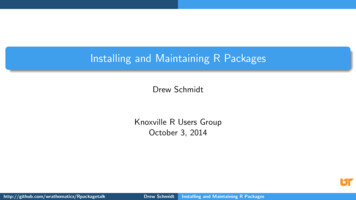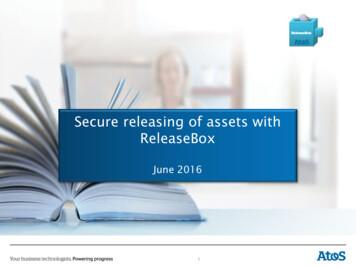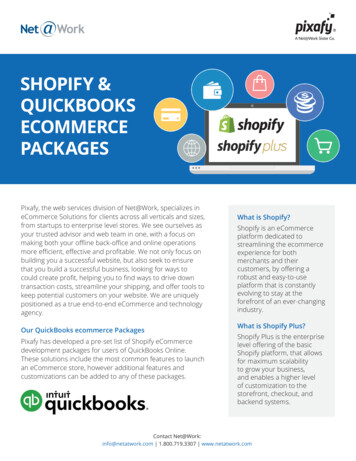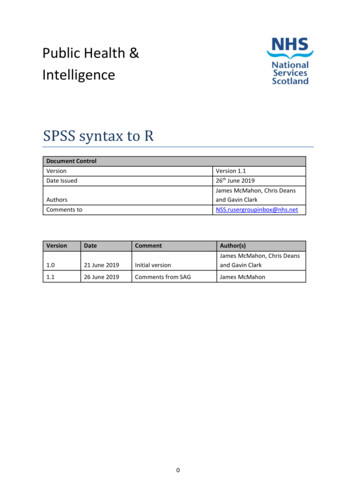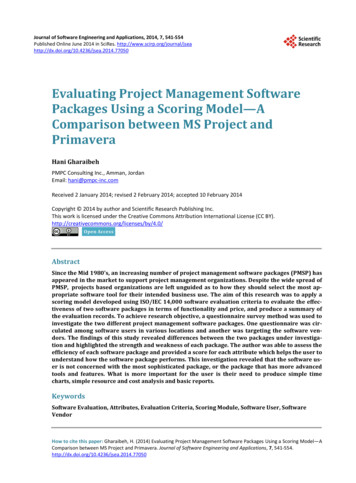
Transcription
Journal of Software Engineering and Applications, 2014, 7, 541-554Published Online June 2014 in SciRes. /10.4236/jsea.2014.77050Evaluating Project Management SoftwarePackages Using a Scoring Model—AComparison between MS Project andPrimaveraHani GharaibehPMPC Consulting Inc., Amman, JordanEmail: hani@pmpc-inc.comReceived 2 January 2014; revised 2 February 2014; accepted 10 February 2014Copyright 2014 by author and Scientific Research Publishing Inc.This work is licensed under the Creative Commons Attribution International License (CC tractSince the Mid 1980’s, an increasing number of project management software packages (PMSP) hasappeared in the market to support project management organizations. Despite the wide spread ofPMSP, projects based organizations are left unguided as to how they should select the most appropriate software tool for their intended business use. The aim of this research was to apply ascoring model developed using ISO/IEC 14,000 software evaluation criteria to evaluate the effectiveness of two software packages in terms of functionality and price, and produce a summary ofthe evaluation records. To achieve research objective, a questionnaire survey method was used toinvestigate the two different project management software packages. One questionnaire was circulated among software users in various locations and another was targeting the software vendors. The findings of this study revealed differences between the two packages under investigation and highlighted the strength and weakness of each package. The author was able to assess theefficiency of each software package and provided a score for each attribute which helps the user tounderstand how the software package performs. This investigation revealed that the software user is not concerned with the most sophisticated package, or the package that has more advancedtools and features. What is more important for the user is their need to produce simple timecharts, simple resource and cost analysis and basic reports.KeywordsSoftware Evaluation, Attributes, Evaluation Criteria, Scoring Module, Software User, SoftwareVendorHow to cite this paper: Gharaibeh, H. (2014) Evaluating Project Management Software Packages Using a Scoring Model—AComparison between MS Project and Primavera. Journal of Software Engineering and Applications, 7, 541-554.http://dx.doi.org/10.4236/jsea.2014.77050
H. Gharaibeh1. IntroductionComputer systems are known to have a role in all aspects of the engineering business. The revolution in the fieldof computer software in the last decade has been enormous. Now, engineers and managers working in the engineering industry can no longer ignore the facilities and tools in computer technology if they wish to becomesuccessful.In the engineering industry, several software packages have been developed to enhance the various projectstages. Starting with the design stage, the marketing of architectural, engineering, and construction software isvery impressive, as it is exemplified by colors, 3-D drawings animation, audio video effects, and much more.Now there are even other software systems that help in cost estimation, construction documents preparation,quantity surveying, and of course, project scheduling and management [1].In the world of project management, computer applications play an increasing role in the delivery of projects.Software programs are involved in just about every aspect of project work from the discovery of a problem or anopportunity, to the commissioning and start-up of the new facility. Computer tools are now involved with everyaspect in the project, providing solutions that will help in faster project completion, lower costs as well as improving the productivity and accuracy of work. Projects require participation and support from all levels withinan organization, and so teams are the foundation of a successful project. Modern software packages providecomprehensive information on all the projects in the business, from executive-level summaries to detailed workassignments, so each team member can confidently contribute to the project’s success.Growth for most businesses is a result of successfully developing a project that generates new products andservices. This day-to-day explosion of new products and services is driving the challenges that face most companies. Limited skilled resources, constantly changing project priorities and shortened development cycles magnify these challenges. Thus, it is no longer business as usual. The ability to make decisions, choose the rightprojects, will determine how effectively projects are deployed and how quickly the company’s products and services get to market.To create strategic business advantages and get the products to market fast, leading companies are effectivelyusing project management. They need the most advanced and modem project management software. Processand resource management software that offers the combined benefits of’ managing projects and building andusing standard methodologies to help companies minimize project lifecycles, and deliver uncompromising project results [2].In the world of engineering and construction, a long time concern has been the concept of project schedulingby CPM. For many in the industry, CPM was seen as a system that somebody else should use. Of all modernengineering and construction tools, CPM was one of the very first to be computerized. CPM was initially aimedto improve construction labor productivity. Eventually other aspects such as, procurement and management decisions were included in the CPM planning networks and schedules. Today there are many CPM-based computer tools for scheduling and project management.Where at one time most schedules showed only construction activities, current usage includes a full range ofproject phases and tasks, including producing, services, site analysis activities, schematic design services, designdevelopment services, and so on. PRIMAVERA offers to manage not only the project time, but also the costsand the use of resources. This is done by estimating activities in terms of their time, their resource requirementsand their cost.The initial concept of CPM was to plan activities using networks of logical relationships and then to createGantt or bar charts to communicate the information. The current marketing approach, however, is to plan thework on screen using bar charts, connecting the bars for logic if needed, and then automatically converting theplan to a CPM/PERT network in a precedence diagram format [1].A widely used package, created for the engineering and construction industry, is Primavera software.PRIMAVERA is now written for Windows as GUI packages (Graphical User Interface). This means that thepackage depends on graphics and charts to illustrate the different tools and functions it provides. PRIMAVERAoffers to organize, analyze, communicate and accelerate projects. The main planning graphic in PRIMAVERA,as in most other GUI packages is the Gantt charts.PMSP although not specially written for the engineering and construction industry, includes: MicrosoftProject and Computer Associates Super. Microsoft Project is seen by some as a lower cost, individual scheduling tool suitable as a feeder to more comprehensive PMSP for large projects, such as Open Plan and Primavera.542
H. GharaibehSome lower price applications are Timeline Track from Primavera and Open Plan Desktop. Sure Track andTimeLine are simple, computerized bar chart drawing tools [1].According to Levine, PMSP can be classified according to three levels/types follows: The Bare Bones Level: The software containing very basic functions operating within limitations. The Mass-Market Level: This project management software attempts to provide the basic tools and featuresfor a variety of project management activities. The Advanced-Moderate Level: These highly sophisticated programs have a resultant increase in complexityand speed of operation [3].Although, this classification of PMSP was proposed by Levine in 1986, the available PMSP tools in the market today still fit neatly into this categorization. The Mass-Market level of PMSP includes packages such as CASuperproject, Micro planner, on Target, Project Scheduler, Timeline and MS-Project for Windows. These software packages range in price from US 200 to US 1000 and provide the general project management techniques of PERT/CPM, Gantt chart, resource leveling, WBS and cost tracking. The downfall of this range ofPMSP is that they do not provide the ability to schedule and track multiple projects, and therefore are only useful for single project.The advanced-moderate level of PMSP are highly sophisticated programs that provide a great number offunctions ranging in price from approximately US 1500 to US 16,000, depending on the functionality and desired hardware platform. These packages include: Cresta PMS, Kemal PMS, Micrplanner X-pert, Primavera,X-pert for Windows, and the majority of the PMSP that require Unix as the hardware platform. These packagesare recommended for multiprojects with several thousand activities or many subcontractors.As software packages are generic, they apply to large segments of the market, ensuring sales and profits forthe software vendor. However, the generalized nature of software packages guarantees that they are not designedto suit all of the functionality requirements of every organization.The purpose of software packages is to provide a relatively cheap product that meets the basic needs of organizations, attempting to solve a problem experienced by many. The other major advantages of software packages are that they can be acquired, installed and operated within weeks, while the level of user support is high [4].In 1994, a survey was conducted with 1500 software professional in North America. The survey analyzedsoftware product installations and purchase plans for the feature/function requirements. The objective of the research was to aid software vendors to better understand user requirements and the decision process buyers undergo when selecting software products. Respondent to the survey cited purchasing off-the-shelf applications asthe most suitable and most popular choice. The survey has also found that product features and functions andease of use have been rated respectively as the number one and two buying criteria for the past eleven years.However, in 1994 user support, that is service and training, overtook the number one and two positions.Different methods are used by different people to select project management software. One approach is studying the experience of others, validating their experience and relating that to your situation. Another approach isto conduct trials on small problems, which will help to understand and use the software. Some project management experts prefer to apply the package or tool on real projects. This has one disadvantage that it is a lengthyprocess and this is only practical as a means of evaluating few products [5].In general, it is advisable to follow recommendations of national bodies, expert group (for example the Project Management institute) or consultants in the project management area. These groups are familiar with software packages and their potential uses for various activities and industry needs.2. The Purpose of Software EvaluationToday the use of information technology is growing; the number of critical computer systems is also growing.The quality of software in these systems is important because software faults may lead to serious consequences.Thus, it is important before starting the evaluation process to define, what is meant by the evaluation of projectmanagement software? It is the process of quantifying the different tools and features provided by a softwarepackage in a way that will help to compare it with different software packages.Software products are extremely varied. They are written and produced to fulfill very diverse requirements.Their context for use can also be very varied, such as in the case of application software in a management information system. The primary purpose of software product evaluation is to provide quantitative results concerning software product quality that is comprehensive and acceptable.543
H. GharaibehThe evaluation process is described as a procedure that allows expression of evaluation requirements in terms ofquality characteristics, as defined in ISO/IEC 9126. The evaluation takes into account various documents thatcan be considered as part of the software product. Design documentation, test or validation reports, andsource code or user documentation. It is recommended by the ISO standards that the evaluator use a library ofevaluation modules that define evaluation methods. These evaluation modules could be standardized, although no provision for that is proposed in the standard. The evaluation leads to the production by the evaluator, of an Evaluation report [6].There are different types of evaluation. The evaluation process can he classified by the party concerned with theevaluation, and the evaluation could be classified based on the stage at which the software is being evaluated [6].3. Objective & MethodologyTo investigate the effectiveness of PMSP, the author has to collect an enormous amount of data for both software users and software vendors. The data collected can be applied using the scoring model developed by theauthor. The best method to achieve this objective is to use a survey/questionnaire method as this method willenable the collection of large amount of data from variety of software users in several locations and from different industries.Surveys are statistical research method used to collect data from a large group of participant. Surveys are veryuseful research instrument to collect data on phenomena that cannot be observed. Surveys could be of differenttypes including: structured, semi-structured and unstructured questionnaire surveys. In a survey, researchers usea random sample to represent the entire population. Basha and Harter in 1980 define population as “any set ofpersons or objects that possesses at least one common characteristic” [7].The best method to achieve this objective was the use of questionnaire survey forms. Surveys are statisticalresearch method used to collect data from a large group of participant. Surveys are very useful research instrument to collect data on phenomena that cannot be observed. Surveys could be of different types including:structured, semi-structured and unstructured questionnaire surveys. In a survey, researchers use a random sample to represent the entire population.Surveys may have advantages as a research method. 1) they are not expensive, 2) participants can respondquickly and can be widely spread geographically, 3) participants can respond after gathering information or taking time to think about their responses, 4) it participants privacy while they respond, 5) allow respondents toread questions rather than hear them loud, 6) those who participate can do so according to what is most convenient for their schedule, 7) participants can look at the entire survey, giving context to questions and 8) participants are also unaware of the feelings or wishes of the researcher [8].The objective of this research paper was to apply a scoring model developed previously by the author basedon ISO/IEC 14598-1 software evaluation criteria to help evaluate two different software packages. The scoringmodel uses a score card which assigns scores for each software attribute in order to assess the effectiveness ofthe software package.4. Data Collection4.1. OverviewThe data collected in this particular research, originates from questionnaires sent to the software user, representing any individual or organization that is likely to use project management software to perform its activities;and the software vendor, being the project management software company that delivers this product to the user.In order to test the validity of this scoring model, the author chooses to assess two different software packagesby applying the model to it. The software packages chosen were: Microsoft Project and Primavera due to theircommon and wide application among engineering and construction firms.4.2. Software User Survey FormThe software user questionnaire would be used to support the vendor questionnaire, by targeting organizationsthat use project management software to monitor and coordinate their projects. In this particular study, a software user survey form was distributed among 110 companies across Australia. The survey form was distributed544
H. Gharaibehin five cities: Sydney, Melbourne, Brisbane, Adelaide and Perth. Almost 35 companies responded to the surveywhich helped to gather data about the assessment of various software characteristic and attributes both from atechnical perspective (so called operational characteristics) and system requirements (so called general information system characteristics).The survey form consisted of the following sections: Section A: which would include general information on the software used by the company, and the size ofproject management activities conducted by them? It would also contain company details. It was hoped thatthis section would reveal the popularity of project management software to those organizations and the degree of importance of the software itself. Section B: which would help weighting the evaluation criteria? It will focus on obtaining a numerical assessment for the different attributes listed in the software evaluation criteria. This assessment represents thedegree of importance of each attribute expressed as a percentage as seen by the software user. This will bereferred to as the weight of the attribute. Each characteristic set itself will have a relative weight and the subcharacteristics included in each criterion will have a different weight as well. The section will be organizedin the form of tables that list the main characteristics used and the sub characteristic sets associated with it, aswell as, the different attributes associated with each sub characteristic set in separate tables. Each table consists of two columns. Column one that lists the characteristics/attributes and column two contains the degreeof importance given to the particular attribute in terms of the overall characteristics examined. Section C: This would involve the attributes. This section was part of the questionnaire sent to softwareusers who are using either MS-Project or Primavera in planning to help in scoring the attributes listed inSection B, and give their personal judgment of how the tested software achieves each attribute. The scorewill be assigned based on a point scale (0 - 3). It will reflect the performance of the software package inrespect to each attribute. Where zero represents a poor performance and 3 represents an excellent performance.Finally the user was allowed to comment on the contents of the questionnaire and the investigation itself.To be assigned a score, the software package must achieve the condition stated for each performance category.Since this is a subjective assessment that might differ from one person to another, the four point’s scale as illustrated in Table 1 was selected to minimize the personal error in each assessment. Once the scores are obtainedfor all the attributes, it will be installed into the scoring module. For each of these attributes listed in the modelthe following were calculated: a score that represents the assessment of the software user to how each softwarepackage covers this attribute, a relative weight (X) of each sub-characteristic set defined within the operationalor general information system characteristics, and a weighted score was calculated by multiplying the score ofeach attribute with the relative weight of that sub-characteristic set. Finally a relative weighted score (Y) foreach sub-characteristic set was calculated to be the sum of all the weighted scores of the attributes that belongsto it.4.3. Software Vendor Survey FormTwo software vendors in the investigation were Primavera Systems Inc., and Microsoft Corporation, whichproduce the software Microsoft Project. Both vendors have an outstanding reputation in Australia and worldwide. Their products are widely used at both the individual and organizational level.The data collected using this questionnaire was necessary to the evaluation process to be used in the scoringmodule. The structure of the questionnaire consists of three sections: Section A, the general information, SectionB, the general system requirements and Section C, the life cycle cost information.Section A covered general information including the software company details and the respondent’s name.This section meant to help estimate the size of the software company both in Australia and worldwide and tohelp establish a general background on the experience of the software company in the field of project management.Section B will cover the data required in evaluating the general system characteristic, including informationon technical support, compatibility, training, security and hardware requirements.Section C presents the collected data necessary to work out all the different cost items associated with thesoftware package. Such information will help in evaluating the third characteristic set, which is the cost of thesoftware package. These cost items are listed in Table 2.545
H. GharaibehTable 1. Scoring criteria for each software attribute.ScorePerformanceCondition0PoorIf the attribute does not exist at all in the software package1BadIf the attribute exist, but presented badly(there are minor problems, weak points in the use of attribute)2GoodIf the attribute is achieved within minimum requirements or average performance3ExcellentIf the attribute is expressed very well with powerful tools provided in this attributeTable 2. Software cost elements.Cost ItemUnitPurchase cost of software /licenceInstallation fee /licenceMaintenance cost /yearUpgrading cost /yearHardware equipment cost Learning cost of the software Expected operating lifeyearsTotal cost of the software The cost is a significant part of the evaluation process, since a decision to purchase a software package willvery much depend on the cost of the package as well as other considerations. It was for this reason that, the userwas given the choice in the questionnaire form to rate the degree of importance of the cost from amongst theother criteria items. Two questionnaire forms were sent out one for Primavera Systems Inc. (Brisbane) and theother one to Microsoft Australia Corporation (Sydney). Results of the data collected in these questionnaires willbe discussed later in this paper.5. Data AnalysisSince software is considered the main topic of this investigation, it was extremely important to collect information regarding both the software packages under investigation. Indeed this information was most useful in the evaluationprocess. Both companies: Microsoft Australia Corporation and Primavera Systems Inc. responded to the questionnaire.As indicated in the second part of the survey forms, both software providers satisfy the documentation requirements identified in the evaluation criteria. They provide the user with user and technical manuals whenpurchasing the software. In addition to that, they provide auxiliary materials such as demo CDs, brochures,booklets, etc. This approach is important as the software user ranked the documentation of the software as thesecond most important item in the general system requirements of the software, with a relative weight of 20%.In the documentation characteristics, PRIMAVERA achieved superiority over MS-Project by scoring higher interms of the area of support for user and technical manuals (2 and 2 for PRIMAVERA, 1.73 and 1.8 for MSProject respectively). In contrast, MS-Project scored higher in terms of supporting auxiliary materials with thesoftware (1.6 for PRIMAVERA, 1.7 for MS-Project respectively).With a relative weight of 16% the compatibility of the software came third in terms of the general systemscharacteristic. Both MS-Project and PRIMAVERA satisfy this requirement. However, PRIMAVERA was foundto be compatible with several project management systems. MS-Project was found to be better only in terms ofcompatibility with MS-Office applications, which was expected from a Microsoft product scoring 1.91. PRIMAVERA only scored 1.20 on this attribute. In terms of compatibility with other project management softwareand information management systems, however PRIMAVERA achieved better results scoring 1.5 and 1.8 whileMS-Project scored only 1.3 and 1.7 respectively. In terms of compatibility with programming languages and database management systems, MS-Project is compatible with C , Visual Basic and C sharp. PRIMAVERA is also compatible with C , as well as SAP and the Oracle database.546
H. GharaibehThe technical support sub characteristics came forth in the degree of importance with a relative weight of 15%.This sub characteristic was achieved well in both software packages. Both software suppliers indicated that theyprovide technical services such as: implementation, consultation and training courses on the use and applicationof the software package. Additionally both vendors conduct seminars and workshops to introduce the new userto the last updated versions of their products. The attributes in the technical support were another success forPRIMAVERA over MS-Project. MS-Project was only better in the process of installing and operating the software, scoring 2.27, while PRIMAVERA scored only 1.83 on this attribute. Meanwhile, PRIMAVERA scoredbetter in terms of support for technical services and training courses, (2 and 2 for PRIMAVERA, 1.38 and 1.9for MS-Project respectively) on these attributes.With a 40% relative weight, the user friendliness characteristics proved to be the most important item for thesoftware user. In examining the different attributes of this group, MS-Project achieved better results thanPRIMAVERA in terms of a shorter time period to learn the software package, clearer screen messages and dialog boxes, and the undo redo option. PRIMAVERA was better than MS-Project only in terms of the organization of the menu structures and commands.The security sub characteristics of the software came last in terms of the degree of importance for the software user with a relative weight of only 9%. This was because the user was more interested in characteristicslike user friendliness and documentation. However PRIMAVERA achieved a higher success level than MSProject in terms of both security on accessing project files and security on target plans.6. The Scoring ModelIn a previous research phase, the author developed a scoring model based on the ISO/IEC criteria illustrated inFigure 1 and data gathered from variety of software users in the engineering and construction industry. Thescoring model included two type of characteristics to be evaluated in a software package: the operational characteristics which refers to the technical features and tools available within the package which affects the functionality of the software, and the general information system characteristics which refers to the non-technicalsoftware features that are essential to have not only in a project management software package but in any software product. Each level was further broken down into sub-characteristics that define the key aspects that shouldbe present in a PMSP and finally each sub-characteristic was broken down into the smallest measurable units inthe software (the so called attributes). Each attribute was given a weight (0% - 100%) to represent the degree ofimportance of this attribute in terms of the overall assessment criterion.The first step in building the scoring module was to calculate the average score assigned by each softwareuser for each attribute, the average score is called the “aggregated value” and is calculated using the belowformula:Figure 1. Evaluation process as identified by ISO/IEC: 14598-1.547
H. GharaibehAggregated value f(A*0) (B*1) (C*2) (D*3)A B C D(1)where:A: number of users assigning a score of ZERO for a specific attributes.B: number of users assigning a score of ONE for a specific attributes.C: number of users assigning a score of TWO for a specific attributes.D: number of users assigning a score of THREE for a specific attributes.After calculating the aggregated value for each attribute and for both software packages under investigation,the score is then installed into the scoring module.The second step is to determine the weight assigned for each attribute which is a percentage assigned by eachsoftware user to represent the degree of importance of each software attribute in terms of the sub-characteristicset for which this attribute belongs. The average weight is then calculated by summing all the weights assigneddivided by the number of software users responding to the questionnaire. This represents the average weight foreach software attribute. This percentage is inserted in the scoring model.The third step is to calculate the weighted score for each software attribute which is calculated according tothe formula below:Weighted Score Aggregated Score Value * Average Weight(2)The weighted score is then inserted into the scoring model against each software attribute.The fourth step in building the scoring model was to calculate the relative weight (X) for each sub characteristic set which represents the degree of importance of each sub characteristics set in terms of overall softwareevaluation criteria. The relative weight is calculated as an average number resulted by adding all relative weightpercentages assigned by software users and
using project management. They need the most advanced and modem project management software. Process and resource management software that offers the combined benefits of' managing projects and building and using standard methodologies to help companies minimize project lifecycles, and deliver uncompromising pro- ject results [2].
